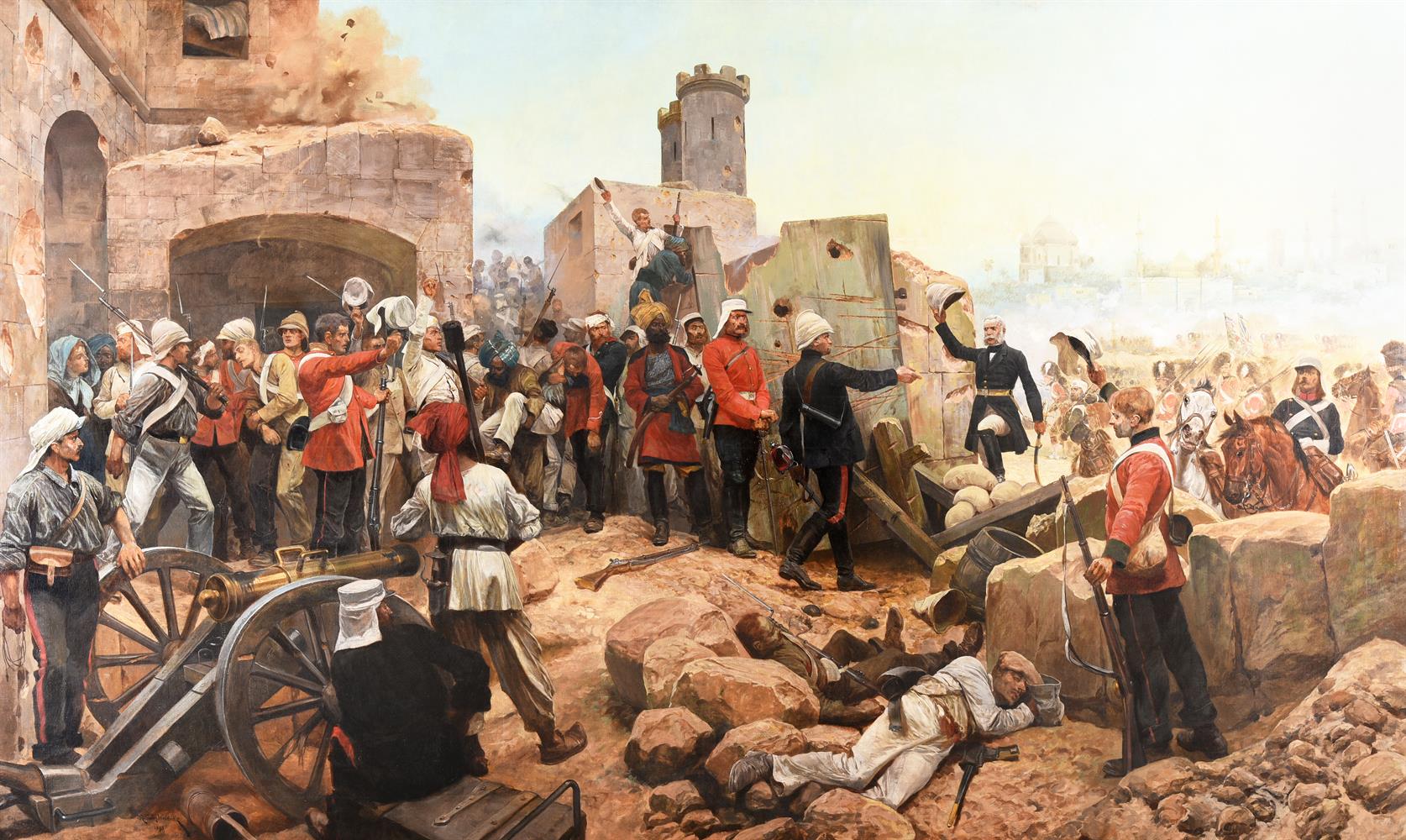The important Indian Mutiny medal awarded to George Schilling, Principal of La Martinière College throughout the siege of Lucknow Indian Mutiny 1857-58, 1 clasp, Defence of Lucknow (G. Schilling) edge nicks, otherwise good very fine £3,600-£4,600 Footnote Provenance: Brian Ritchie Collection, Dix Noonan Webb, March 2005. George Schilling, the Principal of La Martinière College, was born in Dublin 1827 and was educated at King’s College, London. La Martinière, a large and impressive palace, lying a mile south east of Lucknow and about two and a half miles from the Residency, was built by Major-General Claude Martine (1735-1800), a French soldier and adventurer who allied himself to the British. Having amassed a fortune of 28 lakhs, Martine left instructions that on his death he was to be buried in one of the ground floor rooms, and endowed three schools; one in his former residence at Lucknow, one at Calcutta and one in his native Lyons. In March 1857, Schilling, a married man with a daughter, was responsible for 268 pupils and the teaching staff and their dependents, about 100 in all. On hearing of the attacks on Europeans at Meerut and Delhi, Schilling arranged for stocks of food, ‘rice, ghee dall etc., etc.’, and reserves of drinking water in large earthenware pots, to be laid in. A small guard drawn from the 3rd Oudh Military Police was provided, and he also immediately took several other wise precautions, afterwards outlined in his report to the Trustees of the Martine Charities: ‘ ... the Establishment was moved into the main building of the Constantia House; the bigger boys armed, and sentries from among them stationed on top of the building during the day; the duty of keeping watch at night being assigned to the masters. At the same time the bridges connecting the main building with the wings of Martinière were destroyed; the numerous doors in front of the building barricaded, those behind built up with kucha walls, five feet high, and of course the same thickness; all the staircases built up; and also all the doors leading to the central staircase, excepting one filled up with bricks which had been purchased for the construction of a large well.’ On 11 June the cavalry of the Oudh Military Police mutinied and next day the infantry of the Military Police followed suit, but fortunately the guard at the Martinière absconded to join their comrades without first striking a blow at Schilling. The boys, who had been further reduced in number by some returning to their parents, were now sixty-one foundationers and four boarders, and they watched expectantly from the top of the Martinière as a body of mutineers, apparently intent on attacking the College that night, took up a position in a mango tope on the southern boundary of the park. But help from the Residency was at hand and some guns and a party of Lawrence’s Volunteer Cavalry, under Captain Radcliffe, galloped up and went into action. A few rounds of grape at close range scattered the mutineers who were then charged by the Volunteer Cavalry and driven into some trees. Two columns of the H.M’s 32nd Regiment, under Colonel Inglis, appeared in skirmishing order and, advancing into the wooded area, accounted for a number of Sepoys. While all this was going on, Schilling, who was returning from the Residency, ran into some mutineers in the park, but, digging in his heels, was able to escape ‘because of the swiftness of his horse’. A guard of one Sergeant and eight men of the 32nd now replaced the Oudh Military Police at the Martinière, but over the course of the next few days Lawrence decided that it would be impractical to defend the College in the event of a general uprising and on 17 June he issued orders for the school to join the other Europeans inside the Residency perimeter. ‘By order of Sir Henry Lawrence’, reported Schilling, ‘the school was removed into the Residency on the 18th of June; the order came at 4 o’clock the day before, when all preparations for the defe
The important Indian Mutiny medal awarded to George Schilling, Principal of La Martinière College throughout the siege of Lucknow Indian Mutiny 1857-58, 1 clasp, Defence of Lucknow (G. Schilling) edge nicks, otherwise good very fine £3,600-£4,600 Footnote Provenance: Brian Ritchie Collection, Dix Noonan Webb, March 2005. George Schilling, the Principal of La Martinière College, was born in Dublin 1827 and was educated at King’s College, London. La Martinière, a large and impressive palace, lying a mile south east of Lucknow and about two and a half miles from the Residency, was built by Major-General Claude Martine (1735-1800), a French soldier and adventurer who allied himself to the British. Having amassed a fortune of 28 lakhs, Martine left instructions that on his death he was to be buried in one of the ground floor rooms, and endowed three schools; one in his former residence at Lucknow, one at Calcutta and one in his native Lyons. In March 1857, Schilling, a married man with a daughter, was responsible for 268 pupils and the teaching staff and their dependents, about 100 in all. On hearing of the attacks on Europeans at Meerut and Delhi, Schilling arranged for stocks of food, ‘rice, ghee dall etc., etc.’, and reserves of drinking water in large earthenware pots, to be laid in. A small guard drawn from the 3rd Oudh Military Police was provided, and he also immediately took several other wise precautions, afterwards outlined in his report to the Trustees of the Martine Charities: ‘ ... the Establishment was moved into the main building of the Constantia House; the bigger boys armed, and sentries from among them stationed on top of the building during the day; the duty of keeping watch at night being assigned to the masters. At the same time the bridges connecting the main building with the wings of Martinière were destroyed; the numerous doors in front of the building barricaded, those behind built up with kucha walls, five feet high, and of course the same thickness; all the staircases built up; and also all the doors leading to the central staircase, excepting one filled up with bricks which had been purchased for the construction of a large well.’ On 11 June the cavalry of the Oudh Military Police mutinied and next day the infantry of the Military Police followed suit, but fortunately the guard at the Martinière absconded to join their comrades without first striking a blow at Schilling. The boys, who had been further reduced in number by some returning to their parents, were now sixty-one foundationers and four boarders, and they watched expectantly from the top of the Martinière as a body of mutineers, apparently intent on attacking the College that night, took up a position in a mango tope on the southern boundary of the park. But help from the Residency was at hand and some guns and a party of Lawrence’s Volunteer Cavalry, under Captain Radcliffe, galloped up and went into action. A few rounds of grape at close range scattered the mutineers who were then charged by the Volunteer Cavalry and driven into some trees. Two columns of the H.M’s 32nd Regiment, under Colonel Inglis, appeared in skirmishing order and, advancing into the wooded area, accounted for a number of Sepoys. While all this was going on, Schilling, who was returning from the Residency, ran into some mutineers in the park, but, digging in his heels, was able to escape ‘because of the swiftness of his horse’. A guard of one Sergeant and eight men of the 32nd now replaced the Oudh Military Police at the Martinière, but over the course of the next few days Lawrence decided that it would be impractical to defend the College in the event of a general uprising and on 17 June he issued orders for the school to join the other Europeans inside the Residency perimeter. ‘By order of Sir Henry Lawrence’, reported Schilling, ‘the school was removed into the Residency on the 18th of June; the order came at 4 o’clock the day before, when all preparations for the defe

/118474/Internet%20Image%201.jpg)
/66072/Internet%20Image%201.jpg)
/122625/Internet%20Image%201.jpg)



/117656/Internet%20Image%201.jpg)



.jpg?w=400)


/122350/Internet%20Image%201.jpg)
Testen Sie LotSearch und seine Premium-Features 7 Tage - ohne Kosten!
Lassen Sie sich automatisch über neue Objekte in kommenden Auktionen benachrichtigen.
Suchauftrag anlegen